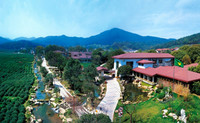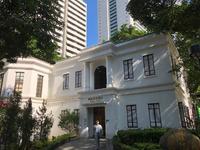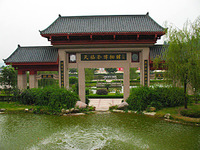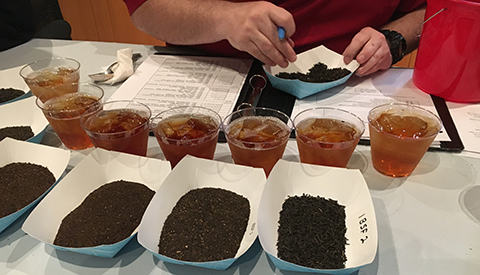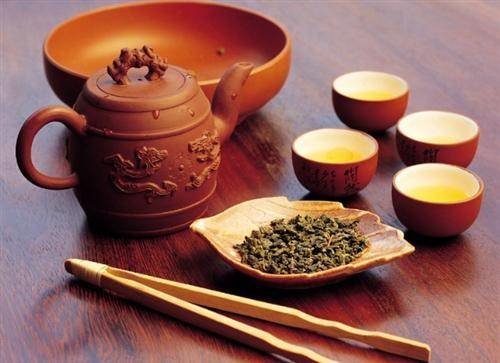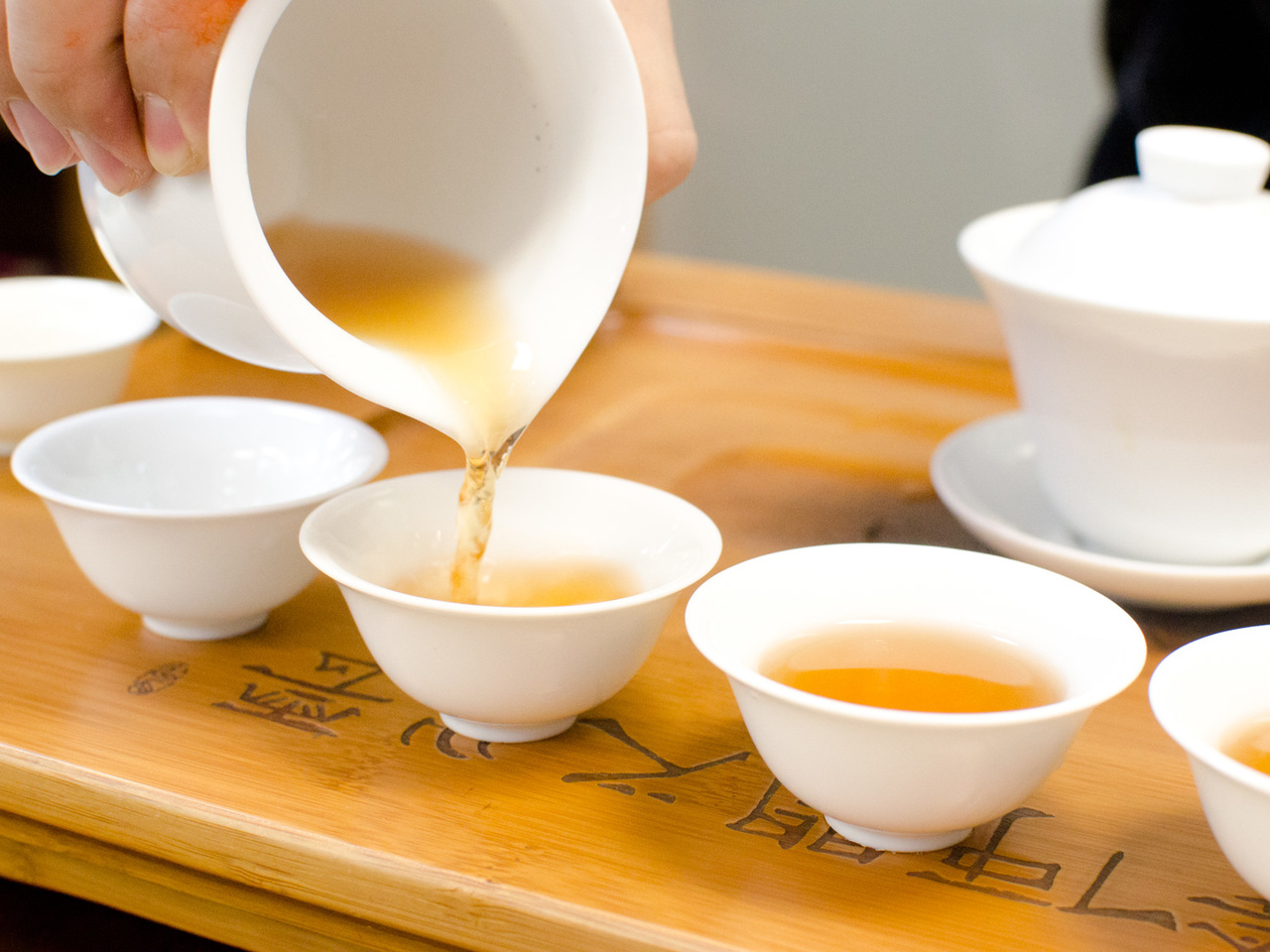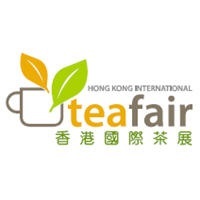| China National Tea Museum | China National Tea Museum | Architecture | Tea Museum
Tea Culture
Tea Ceremony
Tea Ware
Tea Leaves |
|
|
Type:Architecture Subject:Tea Museum
Tea Culture
Tea Ceremony
Tea Ware
Tea Leaves |
Description:The China National Tea Museum was opened in Hangzhou, Zhejiang Province in 1991. It is located in Longjing (Dragon Well) Village, west of charming West Lake, and covers an area of 22,000 square meters (about 5.4 acres) with a 3500 square meter (about 0.9 acres) construction area.
China National Tea Museum is the only one in the country with the tea theme. It has no external walls but is enclosed by vegetation giving the unique impression that the halls and the tea plants inside depend upon each other. Additionally, one hundred distinctive Chinese characters relating to tea are enchased in the road to add color to your trip.
China National Tea Museum is comprised of four groups of buildings which display the history and development of tea in China. The exhibition building is divided into six halls to show the history of growing and processing of tea. They are the Hall of Tea History, the Kaleidoscope Hall, the Hall of Tea Properties, the Tea-friendship Hall, the Tea Sets Hall, and the Tea Customs Hall. Here, different halls illuminate different aspects of tea and its culture in the long history. The Tea Customs Hall is recommended. Here visitors can discover the great impact of tea on the lives of various minority groups of the country. The Kaleidoscope Hall features more than three hundred kinds of tea, including the six basic types of tea of the country and some reprocessed teas. To learn more about these kinds of tea, take a digital earphone upon arrival.
Besides functioning as a museum, here is also a research institution which often holds conferences on tea and its culture. This work has received much attention from government as well as other sectors of society. Inside China National Tea Museum, visitors also have opportunities to see a tea art performance and drink teas in a calm and quiet place. [show more]
|
|
| Museum of Tea Ware | Flagstaff House Museum of Tea Ware | Architecture | Historical Building
Chinese Teaware
Chinese Tea Ceremony
Chinese Tea House
Chinese Tea Brewing |
|
|
Type:Architecture Subject:Historical Building
Chinese Teaware
Chinese Tea Ceremony
Chinese Tea House
Chinese Tea Brewing |
Description:Built in 1846, Flagstaff House was formerly the office and residence of the commander of the British Forces. It is one of the oldest and few remaining colonial buildings in Hong Kong. The Greek revival design style best represents Hong Kong's British colonial history. It was heavily damaged in World War II, and was restored and converted to a branch museum of the Hong Kong Museum of Art in the name of Flagstaff House Museum of Tea Ware in 1984. As indicated in its name, the Museum displays an extensive collection of tea ware. Alongside its exhibitions, the Museum holds regular demonstrations, tea gatherings and lecture programmes to promote ceramic art and Chinese tea drinking culture. Besides, the Museum is now a popular spot of shooting wedding or graduation photos in Hong Kong. [show more]
|
|
| K.S. Lo Gallery | K.S. Lo Gallery | Architecture | Historical Building
Chinese Tea ware
Chinese Tea House
Chinese Tea Brewing
Chinese ceramics and stone seals |
|
|
Type:Architecture Subject:Historical Building
Chinese Tea ware
Chinese Tea House
Chinese Tea Brewing
Chinese ceramics and stone seals |
Description:The Flagstaff House Museum of Tea Ware works together with the K.S. Lo Gallery to offer visitors a wonderful opportunity to enjoy the finest exhibits from the Dr. Lo's lifelong collection, and at the same time makes an important contribution to the promotion of Chinese tea culture. [show more]
|
|
| Tenfu Tea Museum | Tenfu Tea Museum | Architecture | Tea museum
Tea leaves
Teaware
Tea ceremony |
|
|
Type:Architecture Subject:Tea museum
Tea leaves
Teaware
Tea ceremony |
Description:Tenfu Tea Museum, in Zhangzhou, Fujian, China, was constructed in 2000 and finished in 2002. It is the world's largest tea museum[1] with a total area of 13 acres. The museum consists of many displays of past tea cultures, tea processing, tea, and teaware, as well as having live tea arts culture performances. [show more]
|
|
| Tea Competition | Tea Competition | Art | Chinese Tea Culture
The art of tea
Tea competition |
|
|
Type:Art Subject:Chinese Tea Culture
The art of tea
Tea competition |
Description:Tea-competition represents a higher level of tea-tasting. It originated in the Tang Dynasty and came into fashion during the Song Dynasty. Tea-competition was popular among men of letters in the Song Dynasty. Even Emperor Song Huizeng was enthusiastic about them, and the competitions swept through the imperial palace.
The competitors attached great importance to the instruments and materials to be used, as well as the way the competition was to be conducted. Apart from high-quality tea leaves, there were very strict demands on the condition of the tea water. Tanghua (the foaming surface of tea water) was supposed to be fresh, and white, and as fine and even millet grains: If Tanghua disappeared quickly, and thus revealed a trace of water, the competitor was considered a loser.
To win or lose depended on the competitor's manipulation, which invovled two main skills know as "Dian" and "Fu." "Dian" meant pouring boiling water from the tea pot into the tea cup, hence the term "Dian cha" (pouring boiling water over tea leaves). Pouring was performed in such a way that the water flowed down the inner wall of the cup without disturbing the tea leaves. Water was to spurt from the pot in a column, ending as soon as the pouring was finished. "Dian" was not to be performed with drops of water to be the right amount.
"Fu" meant churning the water with a tiny broom-like tool according to a specified procedure in order to create Tanghua. That is why tea competitions were also known as "Ji Fu."
In the present-day process of "Dian" and "Fu," one holds the pot in one hand and the broom-like tool in the other. The two actions are performed with the latter coming slightly later. At each competition, “Dian” and “Fu” are generally done seven ümes. During the sixth time, the water must be examined to see if it is exactly six-tenths of the cup’s volume and how strong it is. Provided both are desirable, no more “Dian” is necessary. If not, one more attempt will have to be made.
The swift spinning of the tool generates a centrifugal force. This force sets the Tanghua serging and billowing like milk-colored mist. The Tanghua around the inner wall of the cup sticks flrmly to it and is called “Yao Zhan” (biting the cup). Tanghua can remain in this state for a while without vanishing and revealing a trace of water. This is considered the highest degree of success in tea-competiüon.
As its name indicates, tea-competition emphasizes competition. When one achieves the desired result, he is filled with a sense of triumph. Tea-competition is carried out in an atmosphere of intense excitement. Even one who prefers drinking in solitude can derive pleasure from it. Consequently, such competition can exert greater spiritual satisfaction for people than other methods of tea drinking. [show more]
|
|
| Tea Drinking | Tea Drinking | Art | Chinese Tea Culture
The art of tea
Tea drinking |
|
|
Type:Art Subject:Chinese Tea Culture
The art of tea
Tea drinking |
Description:Tea is a basic necessity in the life of the Chinese people. To eat and to drink is a matter repeated with regularity every day. Tea-drinking in China has undergone four phases of development.
Primitive men picked tea leaves for food. This practice lasted well into the Spring and Autumn Period. Later on the medicinal value of tea was discovered, and tea water was used to cure diseases. This period may be defined as the first phase of development.
From Pre-Qin Period to Eastern and Western Han dynasties, tea became a beverage. During this period, tea was made with millet and other condiments and was boiled to a porridge-like consistency. This mode of tea-drinking is termed "soup-drinking" and is still popular among some minority nationalities. This represents the second phase.
To grind leaves and leave them to draw in boiling water marks the third phase of tea-drinking. This way of drinking originated in the Three Kingdom Period, was popularized in the Tang Dynasty, and became the prevailing method of tea-drinking in the Song Dynasty. This method is the same as that used in making brick-tea. Unlike the present-day practice, however, such condiments as onion, ginger and lemon had to be added. This phase, in fact, represents a transition to the fourth stage, characterized by pouring boiling water over tea leaves.
This concoction originated in the Tang Dynasty. A new tea-processing technology was invented during this period, which was known as roasting and baking. This method involved picking tender, green leaves in spring and, after proper roasting and baking, making them into whole separate tea leaves. When drinking, one just poured boiling water over the leaves without grinding them. This started a revolution in tea-drinking, initiating the fourth phase of development. During the Song Dynasty, teas made from ground and whole leaves were equally popular. Since the Ming and Qing Dynasties, however, the latter has become the predominant method of tea-drinking in China. [show more]
|
|
| Tea Tasting | Tea Tasting | Art | Chinese Tea Culture
The art of tea
Tea tasting |
|
|
Type:Art Subject:Chinese Tea Culture
The art of tea
Tea tasting |
Description:In ancient times, tea-tasting was among the things that distinguished men of refinement from men of poor taste. One who was not good at tasting tea was usually despised. Jia Baoyu, in the Chinese classical novel Dream of the Red Mansion, prided himself in his detachment from worldly concerns and generally regarded common people as base, but because he was ignorant in tea-tasting, he was mocked by Miao Yu (a nun in the book), who considered him "a stupid person" who drank "like a fish."
Tea-tasting consists of four steps: smelling, looking, tasting and relishing. Like meditation, tea-tasting requires an inward-turned mind in a peaceful world. Three prerequisites, formulated in the Song Dynasty, are required for tea-tasting. First, the tea leaves must be fresh, the water must be from a spring, and the tea service must be exquisite. Second, the weather must be ideal, with gentle breezes and a brilliant sun. Third, the participants must be of refined manners and congenial with the host. Stricter demands were imposed on tea-tasting in the Ming Dynasty, when the "Thirteen Appropriatenesses" and "Seven Taboos" evolved.
The number of participants at a tea-tasting should be limited. Chen Jiru, of the Ming Dynasty, believed that one drinking in solitude could best appreciate the divine quality of tea, two drinking together could get the delight of it, three drinking together could only get the flavor of it, and when seven or eight people drank together, tea-tasting would become nothing more than charity tea that quenched thirst. The merit of tea-tasting resides in its aroma, its color, and its taste, which launches the drinker into a new and fantastic world. [show more]
|
|
| Ming Cha Tea House | Ming Cha Tea House | Business group | Tea House
Tea Tasting
Tea Ware
Tea Ceremony |
|
|
Type:Business group Subject:Tea House
Tea Tasting
Tea Ware
Tea Ceremony |
Description:A hidden treasure located on a factory building in Chai Wan, Hong Kong where MingCha Tea Masters will guide you to explore teas and tea wares during tea tasting activities. It is listed on many travel guide platforms and awarded as one of the World’s Best Tea Shops by Food & Wine Magazine. Founded in 1999, the tea house’s vision is to create an environment where people can understand the real tastes of tea from different angles. The teas are sourced from small traditional farms in China and use traditional production methods to ensure the finest quality. [show more]
|
|
| Hong Kong Park | Hong Kong Park | City Park | City Park |
|
|
Type:City Park Subject:City Park |
Description:An oasis of green in an urban setting, Hong Kong Park is outstanding in the way its design blends in with the surrounding natural landscape. The park features an aviary, a greenhouse, the Flagstaff House Museum of Tea Ware, the Hong Kong Visual Arts Centre, fountains, lily ponds, playgrounds, a restaurant, and even a marriage registry. The aviary features more than 80 species of birds in a well-designed tropical ‘rainforest’.
Also noteworthy is the way flowing water has been employed as a thematic motif to link the different features of the park by waterfalls, streams, ponds, and cliffs made from artificial rocks. The park is also a great vantage point to take some snaps of the surrounding skyscrapers. [show more]
|
|
| 11th HKTDC Hong Kong International Tea Fair 2019 | 11th HKTDC Hong Kong International Tea Fair 2019 | Exhibition
Competition | HKTDC
Hong Kong International Tea Fair
The International KamCha Competition (Hong Kong Style Milk Tea) |
|
|
Type:Exhibition
Competition Subject:HKTDC
Hong Kong International Tea Fair
The International KamCha Competition (Hong Kong Style Milk Tea) |
Description:Showcasing Hong Kong’s status as the region’s premier tea trading hub, the HKTDC Hong Kong International Tea Fair attracts international buyers and local consumers seeking quality teas and tea-related products. The event will feature an interesting line-up of tea-related exhibits, including processed tea and tea products; tea packaging; tea processing equipment and testing service; tea ware; tea bars/organisations; tea technology; tea craft; books & decorative crafts and art; tea media; as well as friends of tea like bakery products.
There will be fascinating events such as International Cup Warming, Tea Forums, International Tea Tasting Sessions and International Tea Art Performances. Meanwhile, displays of teaware and books in the Tea Gallery will help promote the culture of tea drinking. The International Final of the International KamCha Competition (Hong Kong Style Milk Tea) will crown the “King of KamCha” from international finalists.
Concurrent events include the HKTDC Food Expo, International Conference of the Modernization of Chinese Medicine & Health Products, Home Delight Expo, and Beauty & Wellness Expo. [show more]
|
|
